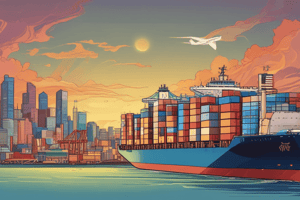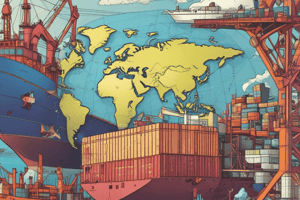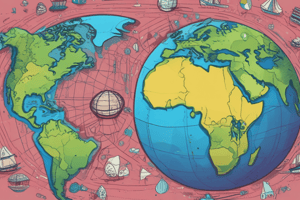Podcast
Questions and Answers
Tariffs are a type of trade barrier that limits the quantity of goods that can be imported.
Tariffs are a type of trade barrier that limits the quantity of goods that can be imported.
False (B)
GDP is a measure of the total value of goods and services produced within a country's borders over a specific period of time.
GDP is a measure of the total value of goods and services produced within a country's borders over a specific period of time.
True (A)
Economic growth is a key concept in microeconomics.
Economic growth is a key concept in microeconomics.
False (B)
Open market operations are a tool of monetary policy that involves changing the reserve requirements of banks.
Open market operations are a tool of monetary policy that involves changing the reserve requirements of banks.
Human development is a key concept in economic development that focuses on the improvement of health, education, and living standards.
Human development is a key concept in economic development that focuses on the improvement of health, education, and living standards.
Flashcards are hidden until you start studying
Study Notes
International Trade
- Definition: Exchange of goods and services between different countries
- Benefits:
- Increased efficiency: Countries specialize in producing goods and services in which they have a comparative advantage
- Increased variety: Access to a wider range of goods and services
- Economic growth: Trade can lead to increased economic growth and job creation
- Types of trade:
- Import: Purchase of goods and services from another country
- Export: Sale of goods and services to another country
- Balance of trade: Difference between the value of imports and exports
- Trade barriers:
- Tariffs: Taxes on imported goods
- Quotas: Limits on the quantity of goods that can be imported
- Embargoes: Complete ban on trade with a specific country
Macroeconomics
- Definition: Study of the economy as a whole, focusing on aggregate variables such as GDP, inflation, and unemployment
- Key concepts:
- Gross Domestic Product (GDP): Total value of goods and services produced within a country's borders
- Inflation: Sustained increase in the general price level of goods and services
- Unemployment: Number of people able and willing to work, but unable to find employment
- Macroeconomic goals:
- Economic growth: Increase in the production of goods and services
- Price stability: Low and stable rate of inflation
- Full employment: Low rate of unemployment
Economic Development
- Definition: Process of improving the economic well-being of a country or region
- Key concepts:
- Economic growth: Increase in the production of goods and services
- Structural change: Shift from traditional to modern industries
- Human development: Improvement in health, education, and living standards
- Factors influencing economic development:
- Institutional factors: Government policies, laws, and regulations
- Human capital: Education, skills, and experience of the workforce
- Natural resources: Availability of natural resources such as oil, gas, and minerals
Microeconomics
- Definition: Study of individual economic units such as households, firms, and markets
- Key concepts:
- Opportunity cost: Value of the next best alternative forgone
- Supply and demand: Determinants of the price and quantity of a good or service
- Consumer behavior: Study of how households make decisions about what to buy and how much to pay
- Market structures:
- Perfect competition: Many firms producing a homogeneous product
- Monopoly: Single firm producing a product
- Oligopoly: Few firms producing a product
Monetary Policy
- Definition: Actions of a central bank to control the money supply and interest rates
- Tools of monetary policy:
- Open market operations: Buying or selling of government securities to increase or decrease the money supply
- Reserve requirements: Minimum amount of reserves that banks must hold
- Interest rates: Rate at which banks borrow and lend money
- Goals of monetary policy:
- Price stability: Low and stable rate of inflation
- Maximum employment: Low rate of unemployment
- Moderate long-term interest rates
International Trade
- International trade is the exchange of goods and services between different countries, allowing countries to specialize in producing goods and services in which they have a comparative advantage.
- Benefits of international trade include increased efficiency, increased variety, and economic growth, leading to job creation.
- Trade can be classified into import (purchasing goods and services from another country) and export (selling goods and services to another country).
- Balance of trade is the difference between the value of imports and exports.
- Trade barriers include tariffs (taxes on imported goods), quotas (limits on the quantity of goods that can be imported), and embargoes (complete ban on trade with a specific country).
Macroeconomics
- Macroeconomics is the study of the economy as a whole, focusing on aggregate variables such as GDP, inflation, and unemployment.
- Gross Domestic Product (GDP) is the total value of goods and services produced within a country's borders.
- Inflation is a sustained increase in the general price level of goods and services.
- Unemployment refers to the number of people able and willing to work, but unable to find employment.
- Macroeconomic goals include economic growth (increase in production), price stability (low and stable rate of inflation), and full employment (low rate of unemployment).
Economic Development
- Economic development is the process of improving the economic well-being of a country or region.
- Economic growth is an increase in the production of goods and services, while structural change refers to a shift from traditional to modern industries.
- Human development involves improvement in health, education, and living standards.
- Factors influencing economic development include institutional factors (government policies, laws, and regulations), human capital (education, skills, and experience of the workforce), and natural resources.
Microeconomics
- Microeconomics is the study of individual economic units such as households, firms, and markets.
- Opportunity cost is the value of the next best alternative forgone, while supply and demand determine the price and quantity of a good or service.
- Consumer behavior involves the study of how households make decisions about what to buy and how much to pay.
- Market structures include perfect competition (many firms producing a homogeneous product), monopoly (single firm producing a product), and oligopoly (few firms producing a product).
Monetary Policy
- Monetary policy refers to the actions of a central bank to control the money supply and interest rates.
- Tools of monetary policy include open market operations (buying or selling of government securities), reserve requirements (minimum amount of reserves that banks must hold), and interest rates (rate at which banks borrow and lend money).
- Goals of monetary policy include price stability (low and stable rate of inflation), maximum employment (low rate of unemployment), and moderate long-term interest rates.
Studying That Suits You
Use AI to generate personalized quizzes and flashcards to suit your learning preferences.




